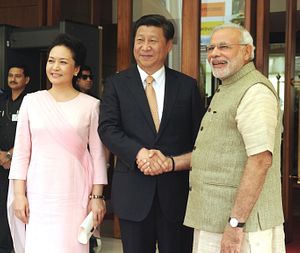Chinese President Xi Jinping proposed the concept of the Maritime Silk Road (MSR) — now a part of the One Belt, One Road initiative — during his visit to Indonesia in October 2013.
The MSR is an attempt to promote economic cooperation and connectivity by reviving the ancient maritime Silk Road trading route. To this end, China has pledged US$40 billion in the Silk Road Fund to develop infrastructure along the route.
The main aim of China’s One Belt, One Road initiative is to develop its landlocked western provinces and enable them to access the markets of Southeast Asia and the Middle East, thus shaping China’s regional periphery by exercising economic, cultural and political influence. India was cordially invited to be a part of the new MSR but so far its response has been lukewarm.
India’s reticence has mainly been due to uncertainty about how the MSR will be implemented, along with concerns as to whether it will have a geoeconomic rationale or a security orientation. The MSR will extend from Quanzhou in China’s Fujian province, heading south to Malacca Strait. From Kuala Lumpur it will head to Kolkata before crossing the northern Indian Ocean to Nairobi.
In China’s view, the MSR will increase maritime connectivity and cooperation on disaster mitigation and the development of fisheries between the Indo-Pacific, East Africa and the Mediterranean. In India, there are diverse views about the initiative. Some are in favor of India becoming an active partner while others are cautious of the covert military side of the MSR.
Many view the MSR as part of a Chinese attempt to reorder Asia and undermine US influence in the region. Another explanation is that the US ‘pivot’ to Asia — which focuses on concentrating additional forces and equipment in the Asia Pacific, along with establishing the Trans-Pacific Partnership (TPP) — is part of a strategy to contain China by the US and its allies in Asia.
China has a tradition of using a checkbook policy against India in South Asia. Under this latest initiative, China is developing ports in Bangladesh, Sri Lanka and Pakistan, and is trying to enlarge its sphere of influence using its economic might in the Bay of Bengal and Arabian Sea. Thus the MSR may be nothing but an economic disguise for the ‘string of pearls’ theory, which concerns the build-up of Chinese commercial and military facilities, and relationships in the India Ocean.
China is investing huge amounts of money in India’s immediate neighbors. These South Asian countries tend to play on this mistrust in order to further their development and economic agendas. More South and Southeast Asian economies coming under China’s sphere of influence would mean a serious setback to India’s traditional conception of the subcontinent as its privileged sphere of influence.
China’s One Belt, One Road initiative — of which the Maritime Silk Road initiative is one part — has an economic and strategic rationale. For more than 35 years, China’s economic development and progress has been mostly concentrated in its eastern, coastal provinces. The initiative seeks to address this while also establishing China as not only an Asia Pacific power but also a global power.
Through the continental project, the Silk Road Economic Belt, China is planning to boost development in the economies of its western provinces and administrative regions. The launch of the project will provide new export markets for Chinese goods and capital. Through this initiative, China will find new markets for exports in central Asia and East Africa where many of the countries have huge domestic demand due to burgeoning middle classes.
In the above backdrop, India is located at such a prime position that it can’t miss out on the opportunity to be part of MSR. Both the maritime and continental Silk Roads are going to traverse India’s periphery. India could gain a lot from being an active partner to the initiative. India has expressed its desire to attract Chinese investments and being part of the MSR will certainly help with that. It would also help India to develop its northeast and further its Act East Policy of prioritizing relations with East Asia. And it could prove to be a perfect platform to enhance India’s regional and bilateral cooperation. Indian investment in neighboring littoral countries could help in reducing China’s sphere of influence and dominance in South Asia to some extent.
More than anything, if India refuses to be part of the Silk Road and the rest of the South Asian and ASEAN countries decide to join then India may become isolated. In this situation, it would be best for India to accept the invitation to join the MSR while availing itself every opportunity to join the US-led TPP.
Geethanjali Nataraj is a senior fellow at the Observer Research Foundation, New Delhi and Policy Lead, Knowledge Partnership Program, DFID India and IPE Global. This was originally published at East Asia Forum here.

































